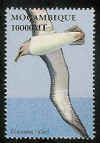The paper's abstract follows:
Many albatross populations are declining and a major cause is believed to be incidental mortality from fishing. We investigated the effect of fishing on southern Buller's albatross Thalassarche bulleri bulleri, using a new approach to seabird population modelling that allows estimation of demographic parameters from multiple data types. Three types of data were used: a 60-year set of mark*recapture observations, four censuses of the breeding population, and estimates of fishing effort and bycatch. The fisheries risk to the viability of this population over the last 60 years appears to have been small, since the adult population is estimated to have increased about five-fold over that time. There is some cause for concern in recent changes (population growth has slowed, and perhaps reversed, and adult survival rates are falling). The most common age at first breeding was 12 years, and about 80% of adults breed each year. Annual survival was estimated to be 0.91 for juveniles, and varied between this value and 1 for adults. Though this population is not in immediate danger from fishing, there is a need for continued monitoring to see whether the recent fall in survival rates persists and causes a decline in abundance. Our analysis showed that when, as is common, mark*recapture data do not provide good estimates of all demographic rates, the assessment of seabird population trends can be improved by the use of other types of data, particularly abundance.

Reference:
Francis, R.I.C.C. & Sagar, P. 2011. Modelling the effect of fishing on southern Buller's Albatross using a 60-year dataset. New Zealand Journal of Zoology DOI: 10.1080/03014223.2011.600766.
John Cooper, ACAP Information Officer, 10 October 2011

 English
English  Français
Français  Español
Español